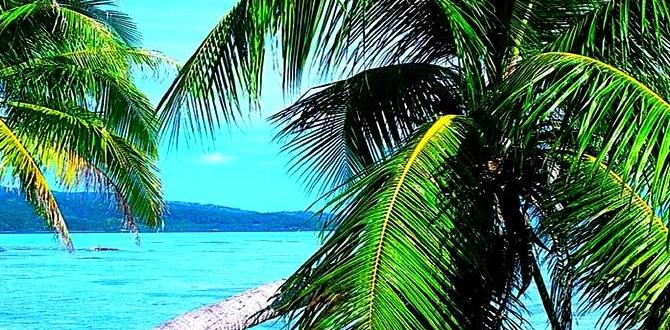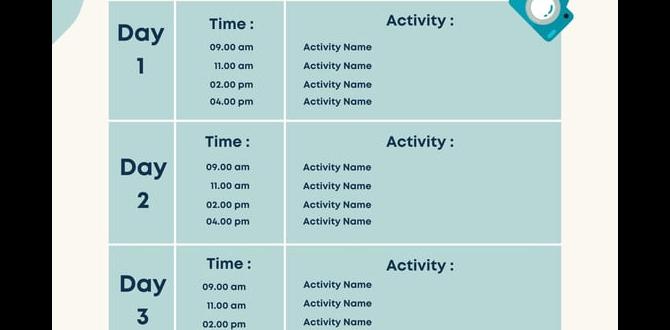Planning an Arches National Park summer trip guide? Focus on early mornings for cooler temps and fewer crowds, booking accommodation months in advance, and packing plenty of water and sun protection. This guide provides essential, beginner-friendly tips for a comfortable and memorable visit to Arches in the summer heat.
Summer in Arches National Park is truly magical, but it can also be surprisingly challenging for first-time visitors. The red rock landscapes glow under the intense sun, offering breathtaking views, yet the scorching temperatures require careful preparation.
Many people find themselves overwhelmed by the heat, the crowds, and the sheer scale of this iconic Utah park. Don’t let that happen to you! My goal is to make your Arches adventure as smooth and enjoyable as possible, providing you with all the essential tips you need for a fantastic summer trip.
Your Essential Arches National Park Summer Trip Guide
Arches National Park is a place of unparalleled natural beauty, famous for its stunning sandstone arches, towering pinnacles, and balanced rocks. Visiting during the summer months offers long daylight hours perfect for exploring, but the desert climate means planning is key to staying comfortable and safe. This guide is designed to help you navigate the park’s unique summer conditions with ease.
Why Summer in Arches Requires Smart Planning
Summer in Moab, the gateway town to Arches, brings high temperatures that can easily exceed 100°F (38°C). This intense heat can limit hiking opportunities during peak daylight hours and poses a risk of heat-related illnesses if you’re not prepared. Combine this with the park’s growing popularity, and you’ve got a recipe for a less-than-ideal experience if you haven’t planned ahead. This guide will equip you with the knowledge to beat the heat, avoid the biggest crowds, and make the most of your summer visit.
When to Visit Arches National Park in Summer
While you’re committed to a summer trip, understanding the nuances of visiting during this season is important. The shoulder months of late spring (May-early June) and early fall (September-early October) are often ideal for average temperatures. However, if summer is your only option, here’s how to make it work:
- Early Morning: Aim to enter the park an hour or two after sunrise. This is when temperatures are most pleasant, and crowds are thinner.
- Late Afternoon/Evening: The hours before sunset can also be a great time to explore as the heat begins to dissipate and the golden hour light bathes the rocks in a warm glow.
- Mid-Day Strategy: For the hottest part of the day (roughly 10 AM to 4 PM), plan for activities that don’t involve strenuous hiking. Think scenic drives, short, shady walks, or visiting the visitor center.
Getting Into Arches National Park: Timed Entry & Reservations
To manage summer crowds and improve the visitor experience, Arches National Park has implemented a timed entry reservation system during peak seasons. It’s crucial to understand this requirement:
- What is Timed Entry? Arches typically requires a timed entry ticket to enter the park between certain hours (e.g., 7 AM to 4 PM) from April to October. Without a reservation, you may not be able to enter the park during these hours.
- How to Get a Reservation: Reservations are released on a rolling basis through Recreation.gov. They typically become available months in advance. Check the official Arches National Park website for the most up-to-date information on reservation windows and release dates.
- What You Need: A timed entry permit is in addition to the standard park entrance fee. You’ll need to book this well in advance.
- Exceptions: If you have a camping reservation or a guided tour reservation within the park, you may not need a separate timed entry permit. Verify with your tour operator or campground.
Tip: Have your Recreation.gov login ready and be logged in before reservations open. They can disappear in minutes!
Essential Packing for Your Arches Summer Adventure
Packing smart is your secret weapon for a comfortable Arches trip, especially with young children or if you require extra personal care items. Comfort and preparedness are paramount when facing desert heat.
Clothing Essentials for Hot Weather
Layering is still key, even in summer, but focus on lightweight, breathable, and moisture-wicking fabrics. Sun protection is non-negotiable.
- Lightweight, Long-Sleeved Shirts: Protect your skin from direct sun exposure. Opt for UPF-rated fabrics.
- Moisture-Wicking T-shirts: For cooler mornings or when you need a change.
- Sun Protection Hat: A wide-brimmed hat is ideal for shading your face, neck, and ears.
- Sunglasses: Protect your eyes from the intense glare.
- Hiking Shorts or Lightweight Pants: Choose quick-drying materials.
- Comfortable Hiking Shoes/Boots: Broken-in and supportive for rocky trails.
- Extra Socks: Wool or synthetic blends are best for wicking away sweat.
- Lightweight Jacket or Fleece: For cooler evenings, especially if camping.
Hydration and Food Supplies
You cannot overstate the importance of hydration in the desert. Plan for more than you think you’ll need. Remember, there are limited services within Arches itself.
- Reusable Water Bottles or Hydration Pack: Carry at least one gallon (about 4 liters) of water per person per day.
- Electrolyte Tablets or Powder: Help replenish salts lost through sweat.
- High-Energy Snacks: Trail mix, granola bars, fruit, nuts, and jerky are great.
- Packed Lunches: Avoid relying on limited concession options.
- Cooler: To keep drinks and snacks cool.
Personal Care and Comfort Items
For travelers of all ages, comfort and convenience are key. This includes ensuring you have supplies for personal needs, especially for children or adults who may require assistance.
- Sunscreen: Broad-spectrum SPF 30 or higher. Reapply frequently.
- Lip Balm with SPF: Don’t forget your lips!
- Insect Repellent: Especially for evenings.
- Hand Sanitizer: For clean hands on the go.
- Wet Wipes: For quick clean-ups.
- Travel Diapers/Adult Diapers: For long days of exploration, especially for children or adults needing extra protection and confidence. Having discreet and reliable options like overnight adult diapers or child diaper products can eliminate stress during extended hikes or road trips, ensuring comfort and preventing any worries about needing immediate facilities. Pack more than you anticipate needing.
- First-Aid Kit: With essentials for blisters, cuts, insect bites, and headaches. Consider including any personal medications.
- Small Towel: For wiping sweat.
Other Important Gear
- Backpack: A comfortable daypack is essential for carrying your water, snacks, and gear.
- Headlamp or Flashlight: Useful for early morning or late evening hikes, and for navigating campgrounds.
- Walking Stick/Trekking Poles: Can provide stability on uneven terrain and reduce strain on knees.
- Camera: To capture the incredible scenery!
- Park Map: While cell service is spotty, a physical map is a lifesaver.
- Portable Phone Charger: Keep your devices powered for navigation and photos.
Navigating Arches National Park: What to See and Do
Even with the heat, there are incredible sights and experiences awaiting you in Arches. The key is to schedule your activities wisely.
Top Arches for Short Hikes & Viewpoints
These trails are generally shorter and offer immense rewards. They are great candidates for early morning or late afternoon adventures.
| Arch/Feature | Trail Description | Distance (Roundtrip) | Elevation Gain | Best Time to Visit |
|---|---|---|---|---|
| Park Avenue | Walk among towering sandstone fins. Mostly flat with some sandy sections. | 1 mile (1.6 km) | Minimal | Early Morning / Late Afternoon |
| The Windows Section (North & South Window, Turret Arch) | Easy, relatively flat paths to massive arches. | 1 mile (1.6 km) total for the loop | Minimal | Early Morning / Late Afternoon |
| Balanced Rock | Short, paved loop with stunning views of the balanced rock formation. Accessible. | 0.3 miles (0.5 km) | Minimal | Anytime (but sunrise/sunset magic) |
Moderate to Strenuous Hikes for the Prepared
For the more adventurous, these hikes offer iconic Arches experiences, but demand extra caution and early starts in summer.
| Arch/Feature | Trail Description | Distance (Roundtrip) | Elevation Gain | Best Time to Visit |
|---|---|---|---|---|
| Delicate Arch | The iconic freestanding arch. Involves a steep climb and exposure to sun. | 3.2 miles (5.1 km) | 480 ft (146 m) | VERY EARLY Morning (sunrise) or Late Afternoon (sunset, be prepared for a dark hike down) |
| Landscape Arch | A long, thin arch stretching across the sky. Mostly flat with sandy sections. | 1.6 miles (2.6 km) | Minimal | Early Morning |
| Devil’s Garden Area (Primitive Loop) | Varying challenges, including slickrock scrambling to reach arches like Double O Arch. | Up to 7.9 miles (12.7 km) for the full loop | Significant, variable | VERY EARLY Morning |
Scenic Drives and Viewpoints
If hiking isn’t feasible during the hottest parts of the day, the park road itself offers incredible vistas. Make frequent stops at pull-offs.
- Arches Entrance Road: Drive slowly and take in viewpoints like Park Avenue.
- Devil’s Garden Viewpoint: Offers a glimpse of the vastness of the area.
- Balanced Rock Viewpoint: Accessible directly from the main road.
- Windows Viewpoint: Easy access to see North and South Window Arches from a distance.
Safety First: Staying Safe in Arches Summer Heat
The desert environment demands respect. Your safety is the absolute priority for a successful Arches trip.
Beat the Heat: Hydration is Key
Dehydration can set in quickly and dangerously in desert heat. Always carry more water than you think you’ll need. Fill up water bottles at the visitor center or in Moab before entering the park, as potable water sources are scarce within Arches.
- Drink water consistently, even if you don’t feel thirsty.
- Add electrolyte supplements to your water, especially on strenuous hikes.
- Avoid alcohol and excessive caffeine, which can dehydrate you.
- Know the signs of heat exhaustion and heat stroke.
Understanding Heat-Related Illnesses
It’s vital for everyone on your trip, from adults to children, to be aware of these risks.
- Heat Cramps: Muscles spasms due to heat and electrolyte imbalance. Rest in shade, drink fluids.
- Heat Exhaustion: Symptoms include heavy sweating, weakness, dizziness, nausea. Move to a cooler place, hydrate, loosen clothing.
- Heat Stroke: A medical emergency. Symptoms include high body temperature, confusion, lack of sweating, rapid pulse. Call 911 immediately.
Tip: For families traveling with children, monitor them closely for signs of discomfort. Parents may also find that using travel-friendly diaper solutions provides an extra layer of comfort and security, allowing for longer outdoor activities without constant worry about needing restrooms.
Sun Protection Strategies
The Utah sun is intense. Protect your skin and eyes at all times.
- Wear sunscreen generously and reapply every two hours, or more often if sweating.
- Use lip balm with SPF.
- Wear a wide-brimmed hat.
- Wear sunglasses to protect your eyes.
- Seek shade during the hottest parts of the day.
Wildlife Awareness
While you might not see large animals frequently, be aware of your surroundings. Watch for snakes, scorpions, and other desert critters, particularly when stepping off established trails or reaching into rocky areas. Never feed wildlife.
Trail Etiquette and Safety
Follow park guidelines to ensure a safe and enjoyable experience for everyone.
- Stay on Trails: Protect fragile desert ecosystems and prevent erosion.
- Pack It In, Pack It Out: Leave no trace.
- Let Someone Know:






